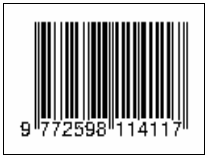Characteristics of Peel-off Gel Mask Formulated from Jicama (Pachyhizus erosus)
Abstract
Full Text:
PDFReferences
Alves, T. F. R., Morsink, M., Batain, F., Chaud, M. V, Almeida, T., Fernandes, D. A., Da Silva, C. F., Souto, E. B., & Severino, P. (2020). Review
Applications of Natural, Semi-Synthetic, and Synthetic Polymers in Cosmetic Formulations. Cosmetics, 7(3), 75–91. https://doi.org/10.3390/cosmetics7040075
Amberg, N., and Fogarassy, C. (2019). Green consumer behavior in the cosmetics market. Resources, 8(3), 137–156. https://doi.org/10.3390/resources8030137
Asben, A., and Kasim, A. (2020). Studi Pembuatan Masker Gel Peel-off dari Bengkuang dan Jahe. Padang. Laporan Hasil Penelitian. Konferensi Nasional – Klaster Dan Hilirisasi Riset Berkelanjutan (KNKHRB). Cao, T. L., & Song, K. Bin. (2019). Effects of gum karaya
addition on the characteristics of loquat seed starch films containing oregano essential oil. Food Hydrocolloids, 97(April), 105198.
https://doi.org/10.1016/j.foodhyd.2019.105198
Cao, T. L., Yang, S. Y., & Song, K. B. (2018). Development of burdock root inulin/chitosan blend films containing oregano and thyme essential oils. International Journal of Molecular Sciences, 19(1), 1–12. https://doi.org/10.3390/ijms19010131
Epstein, H. (2009). Skincare products. In Handbook of Cosmetic Science and Technology, Third Edition. ttps://doi.org/10.1201/b15273-12 FAO. (2021). World Food and Agriculture. Statistical Yearbook. Rome, Italy.
Farage, M. A., Meyer, S., & Walter, D. (2004). Evaluation of modifications of the traditional patch test in assessing the chemical irritation potential of feminine hygiene products. Skin Research and Technology, 10(2), 73–84. https://doi.org/10.1111/j.1600-0846.2004.00054.x
Hudzicki, J. (2012). Kirby-Bauer Disk Diffusion Susceptibility Test Protocol. American Society For Microbiology, December 2009, 1–13.
https://www.asm.org/Protocols/Kirby-Bauer-DiskDiffusion-Susceptibility-Test-Pro Lukitaningsih, E., and Holzgrabe, U. (2014). Bioactive Compounds in Bengkoang (Pachyrhizus erosus) as Antioxidant and Tyrosinase Inhibiting Agents. Indonesian Journal of Pharmacy, 25(2), 68–75. https://doi.org/10.14499/indonesianjpharm25iss2pp 68-75
Luthfiyana, N., & Nurhikma, and Hidayat, T. (2019). Characteristics of Peel Off Gel Mask From Seaweed (Eucheuma cottonii) Porridge. Jurnal Pengolahan Hasil Perikanan Indonesia, 22(1), 119–127. https://doi.org/10.17844/jphpi.v22i1.25888
Martınez-Bustos, F., Lopez-Soto, M., Zazueta-Morales, J.J., and Morales-Sanchez, E. (2005). Preparation and properties of pre-gelatinized cassava (Manihot esculenta. Crantz) and Jicama (Pachyrhizus erosus) starches using ohmic heating. Agrociencia, 39, 275–
Moorthy, S. N., Sajeev, M. S., & Anish, R. J. (2018). Functionality of Tuber Starches. Starch in Food: Structure, Function and Applications: Second Edition, 421–508. https://doi.org/10.1016/B978-0- 08-100868-3.00011-1
Morales, Glauco Sierra, P., Mancilia, Arlett Paredes, Adrián Loyola, Luis A. Gallardo, O., & Borquez, J. (2003). Secondary metabolites from four medicinal plants from northern chile, antimicrobial activity, and biotoxicity against artemia salina. Journal of the
Chilean Chemical Society, 48(2), 13–18. https://doi.org/10.4067/S0717-97072003000200002
Mosquera Tayupanta, T. de los Á., Espadero, M., Mancheno, M., Peña, S., Uguña, A., Álvarez, S., & Vega, M. A. (2018). Sensory analysis of cosmetic formulations made with essential oils of Aristeguietia glutinosa (matico) and Ocotea quixos (ishpingo). International Journal of Phytocosmetics and Natural Ingredients, 5(1), 5–5. https://doi.org/10.15171/ijpni.2018.05
Noman, A. S. M., Hoque, M. A., Haque, M. M., Pervin, F., A., & Karim, M. R. (2007). Nutritional and antinutritional components in Pachyrhizus erosus L. tuber. Food Chemistry, 102(4), 1112–1118. https://doi.org/10.1016/j.foodchem.2006.06.055
Nurman, S., Yulia, R., Irmayanti, Noor, E., & Sunarti, T. C. (2019). The optimization of gel preparations using the active compounds of arabica coffee ground nanoparticles. Scientia Pharmaceutica, 87(4), 32– 48. https://doi.org/10.3390/scipharm87040032
Pinto, D., Lameirão, F., Delerue-Matos, C., Rodrigues, F., & Costa, P. (2021). Characterization and stability of a formulation containing antioxidants-enriched castanea sativa shells extract. Cosmetics, 8(2), 49– 67. https://doi.org/10.3390/cosmetics8020049
Rum, I.A., Suherman, H.W., A., & Idar. (2021). Formulation and evaluation of peel-off gel mask from whole milk yogurt and seaweed (Eucheuma cottonii) as antioxidants sources. Pharmacy & Pharmacology International Journal, 9(4), 132–135. https://doi.org/10.15406/ppij.2021.09.00338
Sankarakutty, S. M. (2020). Harvest and Post-harvest Management in Tuber Crops. In Standard Operating Procedures for AICRP on Tuber Crops (Issue 81, pp. 70–77). Standard Nasional Indonesia. (2007). "Sediaan Tabir Surya". SNI 2007. Jakarta Indonesia. Bandan
Standarisasi Nasional.
Stevenson, D.G., Jane, J., and Inglett, G. E. (2007). Characterisation of Jicama (Mexican potato) (Pachyrhizus erosus L. Urban) starch from taproots grown in USA and Mexico. Starch/Stärke, 59, 132–140.
Tortoe, C., Akonor, P. T., Koch, K., Menzel, C., & Adofo,K. (2017). Physicochemical and functionalproperties of flour from twelve varieties of Ghanaian sweet potatoes. International Food Research Journal, 24(6), 2549–2556.
Vieira, R. P., Fernandes, A. R., Kaneko, T.M., Consiglieri, V. O., Pinto, C.A.S.D.O., P., C.S.C., Baby, A.R., A., & Velasco, M. V. R. (2009). Physical and physicochemical stability evaluation of cosmetic formulations containing soybean extract fermented by Bifidobacterium animalis. Brazilian Journal of Pharmaceutical Sciences, 45(3), 515–525. https://doi.org/10.1590/S1984-82502009000300018
Warnida, H. (2017). Formulasi Gel Pati Bengkuang (Pachyrhizus erosus (L.) Urb.) dengan Gelling Agent Metilselulosa. Jurnal Ilmiah Manuntung, 1(2), 121. https://doi.org/10.51352/jim.v1i2.23
Refbacks
- There are currently no refbacks.









